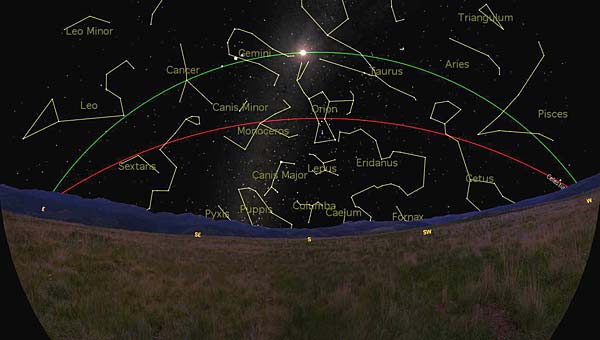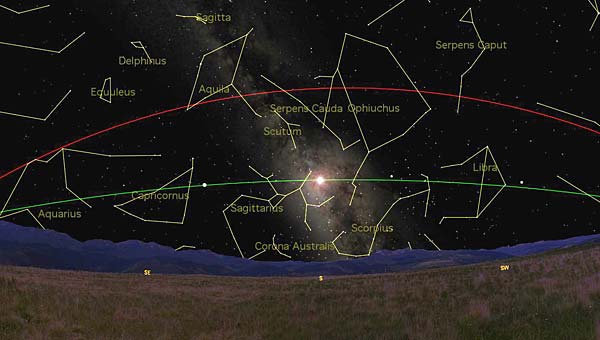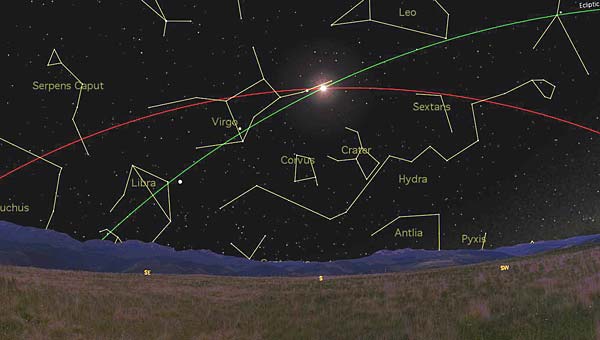Additional Reading at www.astronomynotes.com:
We are still not done talking about the apparent changes of the Sun in the sky. You now know that the Sun appears to move from east to west because of the rotation of the Earth, and that if you could see the stars during the daytime it would appear to drift with respect to the stars by a small amount each day because of the orbit of the Earth around the Sun. The next question is:
Does the apparent path of the Sun across the sky change during the year?
Again, let’s consider two extreme cases—December and June. Think about the appearance of the Sun in winter and then in summer. If you live at roughly the same latitude as central Pennsylvania, you should remember that the Sun never gets very high above the horizon in December, but in June it passes almost (but not quite!) directly overhead. So, the apparent path of the Sun does change from season to season. You can also observe this effect if you re-run the animation on the previous page; in June, the Sun is high above the horizon, in September it is lower, and in December it is very low on the horizon.
The cause of this effect is that the axis of the Earth’s rotation (the imaginary line that passes from the North Pole through the Earth to the South Pole) is tilted with respect to the Sun by an angle of 23.5 degrees. If you go back and look at the animation of the rotating Earth on the day and night page in this lesson, you will see that the line indicating the axis of rotation is not vertical, but is offset by 23.5 degrees from the vertical. As the Earth orbits the Sun, the orientation of the Earth stays fixed, and as a result, in December, the northern hemisphere is tilted away from the Sun during the day, and in June the northern hemisphere is tilted towards the Sun during the day.
There are two consequences of the tilt of the Earth’s rotation axis:
- When the hemisphere you are located on is tilted towards the Sun, the path of the Sun across the sky will be longer than when the hemisphere you are on is tilted away from the Sun. That is, there are more hours of daylight during summer than there are during winter.
- When the hemisphere you are located on is tilted towards the Sun, the light from the Sun is hitting the Earth more directly where you are located than when the Earth is tilted away from the Sun. This means more energy is hitting each square meter of Earth during summer than winter, making summer days hotter than winter days.
Try This!
To help visualize this, you can do a simple demonstration if you have a desktop globe and a lamp with a bare bulb. Most globes are set with their axis of rotation set to 23.5 degrees from vertical. In a dark room, place the globe on a table so that the northern hemisphere is tilted towards the lit lamp, which represents the Sun. You should see that if you pick out a spot, say Pennsylvania, and then watch that spot as you spin the globe, Pennsylvania will get light from the lamp for about 2/3 of its path as it rotates on the globe. If you now move the globe to the other side of the lamp (that is, the northern hemisphere should now be pointing away from the lit lamp), this simulates Earth's position six months later. If you again pick out Pennsylvania on the globe and watch it as it spins, it will receive light from the lamp for only about 1/3 of its path as it rotates on the globe.
Note that the tilt of the Earth is neither towards nor away from the Sun during March and September (Spring and Autumn). Thus, the path of the Sun across the sky and the angle of the Sun’s rays is similar during these two seasons, which is why the length of the day and the daytime temperatures are similar.
There is a nice animated demo from PBS that helps illustrate this effect: Cycles in the Sky: Crash Course Astronomy #3.
Recall that the ecliptic is the path of the Sun across the sky; it can be represented by an imaginary circle in space. If we take the Earth’s equator (another imaginary circle) and project it on the sky, the angle between the ecliptic and the celestial equator would be 23.5 degrees because of the tilt of the Earth. Because the tilt of Earth's rotation axis gives rise to the angle between the ecliptic and the celestial equator, astronomers refer to the tilt of Earth's rotation axis as the "obliquity of the ecliptic". There are four special points on the ecliptic (and note that since the ecliptic is the same thing as the path of the Earth around the Sun, points on the ecliptic are the same things as dates on our calendar):
- Equinoxes - The equinoxes are the two points on the ecliptic where it crosses the celestial equator. On the vernal and autumnal equinoxes (around March 21 and September 21 respectively) the length of the day and night are roughly (but not exactly!) equal.
- Solstices - The points on the ecliptic when the Sun is highest above or lowest below the celestial equator are called the solstices. On the winter solstice (around December 21 in the Northern Hemisphere), the night is much longer than the day, and on the summer solstice (around June 21 in the Northern Hemisphere), the day is much longer than the night. See the three figures below for a comparison between the celestial equator (red line) and the ecliptic (green line):



So, why do we experience seasons?
This emphasizes one major point that is the most misunderstood fact in astronomy:
The Earth experiences seasons because of the tilt of its axis of rotation. The seasons have nothing to do with the distance of the Earth from the Sun.
There is one observation that should help you remember the cause for the seasons. The seasons are opposite in the northern and southern hemispheres on the Earth. That is, it is summer in Pennsylvania from June through September, but in South Africa, it is wintertime during these same months! This is easy to explain if you understand that the Earth’s tilt causes the seasons; when the northern hemisphere is tilted towards the Sun (summertime), the southern hemisphere is tilted away from the Sun. If the distance between the Earth and the Sun caused the seasons, then it would have to be summer in both the northern and southern hemispheres at the same time, because both would be the same distance from the Sun at the same time. Do you know when the Earth is closest to the Sun? In January!
Often, when confronted with the understanding that it is the tilt of the Earth's rotation axis that causes the seasons, students who feel strongly that the reason the seasons must be a difference in distance from the Earth to the Sun will point out that the hemisphere tilted towards the Sun is now closer to the Sun. However, the Earth is so far from the Sun that the difference in distance to the Sun between the hemisphere tilted towards the Sun and the one tilted away from the Sun is effectively zero.